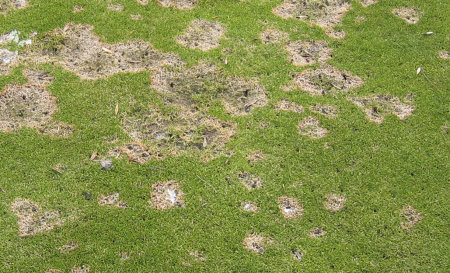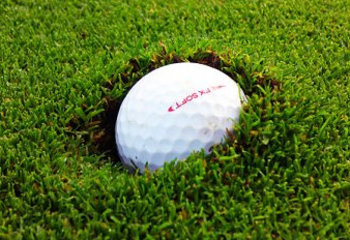
One of my life hobbies, says Lorne Smith 0f Fine Golf, has been playing new golf courses, now over 400 and I instinctively discovered the most enjoyable to play, with what I describe as a high star rating of ‘joy to be alive’, were the links, heathland and some of the downland and moorland courses, rather than as a generality the lush parkland courses.
Why was this?
- The tight fairway turf is cleaner from which to squeeze the ball and gain some backspin control.
- The firm greens meant one has to be creative and imaginative in how one gets the ball near the pin, rather than relying on soft turf to check or plug ones ball having hit it the correct measured distance (ie target golf).
- The tightly mown sculptured run-offs around the greens were more predictable in their bounce and more interesting in the use of their contours.
- They give the finest, truest greens where putts will run-out predictably thereby improving your confidence.
I came to call this “finegolf” after Frank Pennink’s ‘Golfer’s Companion’ book, published in 1962, which reviewed “128 of some of the finest courses in Great Britain and Ireland (GB&I)” and after 40 years I eventually by 2004 had played them all.
But I still had not twigged the real connection until I came across Jim Arthur’s sharp, amusing and campaigning bible of natural greenkeeping ‘practical greenkeeping’ and the scales suddenly dropped from my eyes, as the true bible would say, as I realised the one thing they all had, (apart from the overall attractive environment and views, their design, the clubhouse and facilities, etc.), was fine wiry firm turf on well drained, poor soil terrain that encouraged indigenous fescue/browntop bent grasses and hindered annual-meadow-grass (Poa annua) invasion.
It’s not just my subjective feel that says they give most enjoyment, professional organisations like the STRI have objectively proved in tests on some 4000 greens across 580 British courses over the last five years, and in conjunction with Barenbrug on test sites that “in all aspects of smoothness, trueness, high green speed, dryness, firmness and low thatch content, greens with a higher proportion of fine grasses give better outcomes of putting performance all the year round, than those dominated by annual-meadow-grass (Poa anuua)”.
If fine grasses give the highest enjoyment factor to the serious golfer why are there so few of the thousands of golf courses around the world with fescue/browntop bent dominant greens?
The first simple answer is that fescue/browntop bent grasses do not like a hot season climate, like you find for example in Florida or south east Asia or southern Europe.

One of the types of courses where one is likely to find fine grasses is on linksland next to the sea. George Peper and Malcolm Campbell in their brilliantly researched book ‘True Links’ (read FineGolf’s book review) published in 2010, argued that there are no more than some 246 links courses in the world and they identified them as all being in cool season climates like Oregan, Tasmania, northern Europe and GB&I etc. Their analysis also suggests that over 85% are in GB&I.
As the FineGolf book review of ‘True Links’ suggests, there was some confusion at the heart of their concept, as they were really trying to identify all the firm running courses in the world but their target audience thought of these as ‘Links’ so they cut out any courses not within sight of the sea. (Their conundrum was of course for example, having to include Royal Lytham and St Anne’s but cut-out Aldeburgh!) But the point for us is, it is not just on linksland that we find indigenous fescue/browntop bent grasses giving golfers the ‘running game’.
So if, as www.finegolf.co.uk does with its identification of the finest 200 courses in GB&I, we then come down to just GB&I, why are there so few of the 2,800 golf courses with fescue/browntop bent dominant greens?
Having launched the FineGolf website six years ago as a campaign for the fine running game in contrast to target golf, I have gradually come to learn why grass is so controversial and how we appear to be in the midst of an historically important period for recreational golf where the ‘elephant in the room’ that most golf journalists, TV commentators, professional golfers, and the chemical companies want to ignore, is that there is a return to a running game happening and grasses are at the root of it. To support that theory, let me retrace a bit of history.
Following the 1950/60s when professional and amateur championships were all played on the finest running courses, a period of American domination of the professional game took over and brought with it the development of new target style inland courses, built on lush ground near urban conurbations, with big bulldozers.
This brought much sponsorship money into the professional game and events like the team-based, match-play Ryder Cup gained world wide attention through attractive television coverage. At the same time the chemical companies, equipment and ball manufactures grew strongly.
Nevertheless by around the turn of the Millennium it was starting to dawn on both leading American entrepreneurs and British administrators that not everything was rosy in the golf market.
The R&A persuaded Jim Arthur to capture his thoughts into a book that they published ‘Practical Greenkeeping’ that became the bible of natural greenkeeping encouraging fine grasses. At last greenkeeper training could counter the chemical company mantra.
The first major ‘running’ course for decades (apart from a few community developed ones in west coast Ireland) was built at Kingsbarns, near St Andrews by American Mark Parsinen. He recognised that the best investment for the future should attract the high-end overseas golfer who wanted to play classic Scottish links golf and not the target golf of which they had plenty at home.
Parsinen’s revolution at Kingsbarns was based on using modern construction techniques, learnt from the target golf constructors, to change, for golf the not very auspicious, arable meadow land into a well drained and pot bunkered terrain that had a natural links feel with quite outstanding visual sea views.
The Kingsbarns business model of being open only for seven months each year with a pay and play green-fee around £200 has been enormously successful. Parsinen has replicated it at Castle Stuart, going the whole hog with 100% fine fescue grasses and with more imaginative natural green complexes and of course attractive to their target American audience, wide fairways.
The building of Dundonald links, The Renaissance, Spey Valley, Machrahanish Dunes and Trump International have all followed to highlight the return to a running game.
This has also been replicated across the finest recreational based golf clubs where there is an increasing interest in having ‘fescue/bent’ firm greens again.
Whereas in the 1980/90s the fashionable concept ‘lush, all one colour green’ was great, since the millennium even the USGA’s recent president has said “brown is great”
Next year, the US Open will be played on a running course at Chambers Bay in cool season Washington State where the course is predominantly fescue grass.
The Royal and Ancient’s Open Championship and amateur events have always been played on running courses and we have Jim Arthur to thank for that, in his role as agronomist to the Open Championship courses they resisted most of the fashionable urge to go target in the 1980/90s. (While some of even these top-end links courses, it has to be noted, though being firmed-up with tons of sand, still have bent grass greens with a majority of Poa Annua and little if any fescues)
Golfers are demanding higher performance greens all the year round and though Poa annua greens if shaved can putt well in the summer months, they are quagmires in the winter.
The deep rooted, draught and disease resistant fescues and browntop bent grasses need the opposite conditions to the enemy of running golf, the weed annual-meadow-grass (Poa annua).
For the shallow-rooting Poa to give a decently smooth putting surface it needs to be cut low and often. This takes the goodness out of the grass and to keep it alive it has to be replenished with expensive fertiliser and lots of water. The grass is weakened in its resistance to disease, anthronose in the summer and fusarium in the winter becomes rampant and so lots of expensive pesticides have to be added.
If a golf club has plenty of money it can afford to have a non-conservationist high course maintenance budget and then re-turf its greens when they die every so many years. This is not a policy open to the majority of recreational golf clubs.
It is becoming recognised again by many of the old established clubs (particularly because of the recession) that the move to fine grasses with their need for less water, little fertiliser and pesticides is the conservationist way forward.

The development of the science of Soil Biology and use of Tea Composting seems to be a way forward, with courses like Perranporth that have used Tea composting for years proving its efficacy and one might add only needing four greens staff to pursue their austere regime.
The fertiliser and pesticide chemical companies are on the back foot and hurriedly trying to invent new ‘natural’ products.
There is nothing new to the realisation that golf is at its finest as a running game on fescue/browntop bent turf. To quote Jim Arthur “What was surmised a century and more ago has been proven by research and analysis countless times since. The secret of good golf greenkeeping is to copy basic infertile conditions and ensure ideal conditions for deep-rooting by intensive deep aeration. These same principles apply equally to every part of the golf course.”
Putting performance is very subjective and course managers need an objective measurement of reliability to resist the low handicap golfer who has just got on to the greens committee and having watched the brilliant TV spectacle of The Masters that is played on a totally artificial course, demanding the greens be cut lower to create more speed.
The STRI yearly performance check is a helpful objective test but clubs need their course manager to be able to regularly carry out themselves objective measurements of greens reliability performance, to be able to argue successfully for the pursuance of a long term policy. Luckily, what is new is that the late Nick Park set in motion the availability of the ‘greenstester’ that provides a low cost product for this vital role. (see www.finegolf.co.uk/what-is-fine-golf/value-in-finegolf/the-greenstester/)
To sum up: the money is starting to flow away from target golf and in a modern retro-trend back towards the running game. More clubs are going down the conservationist route of introducing fescue/bent grasses to give firmer, truer performance and use less water, fertiliser and pesticides.
Some of the short term commercial interests of the chemical, ball and equipment manufacturers are pulling in the opposite directions and they continue to dominate the regulators of the game.
The USGA’s ‘pace of play’ initiative is one attempt to break out of this straight jacket, but have golf’s administrators created a rod for their own backs by being so focused on short term commercial growth rather than the longer interests of the recreational game?
There is a story to be told about the return to a running game, if the golf journalists and TV commentators can get off the chemical company and equipment manufacturers band wagon and if greenkeepers and agronomists can learn how to present and communicate their case. The serious golfer will listen and take an interest.
With thanks to Laurence Gale, the editor of Pitchcare, where this article first appeared. Lorne Smith invites people to register to receive the free FineGolf bi-monthly newsletter at www.finegolf.co.uk

